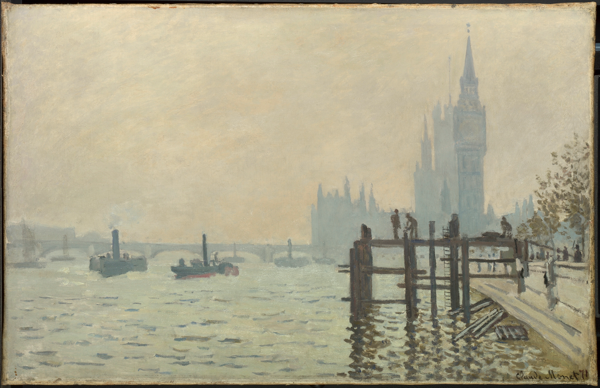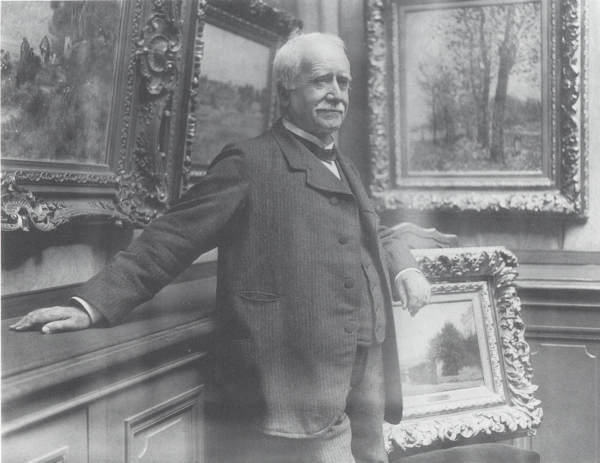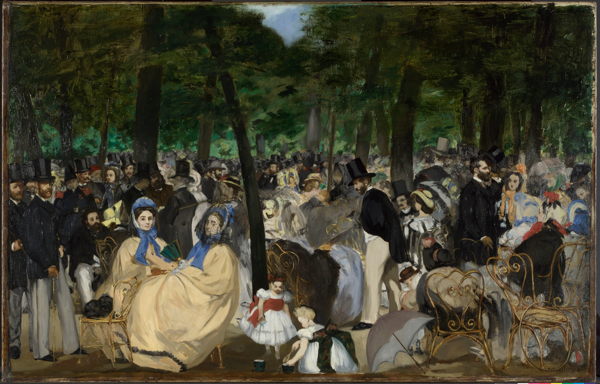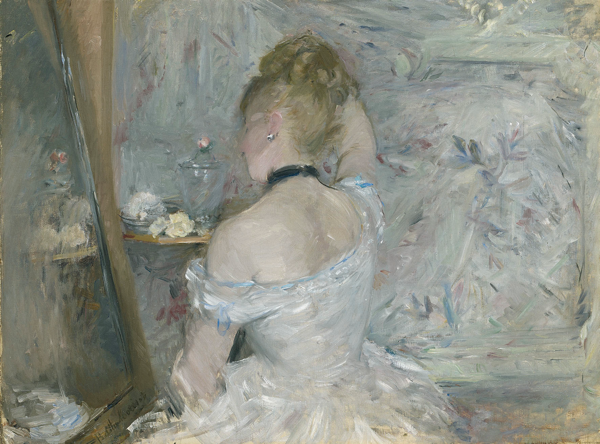Art & Exhibitions
National Gallery of London Sheds New Light on First Modern Art Dealer and Impressionist Champion Paul Durand-Ruel
The National Gallery show proves apolitical art can also be the most radical.

The National Gallery show proves apolitical art can also be the most radical.

Edward Lucie-Smith


Photograph of Paul Durand-Ruel in his gallery, taken by Dornac, about 1910
Archives Durand-Ruel
My first reaction to the Durand-Ruel show at London’s National Gallery (NG) was simply “Wow!” A top class display of always-popular Impressionist painting, it’s sure to draw the crowds.
“Inventing Impressionism, How Paul Durand-Ruel created the Modern Art Market” has already been seen at the Musée du Luxembourg in Paris, and will later go on to the Philadelphia Museum of Art. Panels with blown up photographs give an idea of how these works were originally presented to the public of their time by the great dealer Durand-Ruel, who did so much to establish the Impressionist movement as an international force (see Guarantees Spur Sotheby’s Impressionist and Modern Sale to Record £186.4 Million).
The exhibition’s thesis is twofold.
First, that major art dealers (a new species from the closing years of the 19th century onwards) do not deserve their bad reputations as devious exploiters of both artists and clients.
Second, that Durand-Ruel was a pioneer in creating the kind of high-end art world we have today—the world of big international exhibitions of contemporary work, and of mega commercial set-ups such as the Gagosian Galleries and White Cube. These assertions are, I think, only partly sustainable.
Dealing in what one might describe as “ready-to-hang art” really dates from, and is linked to, the rise of printmaking.
Albrecht Dürer’s mother was one of the first art dealers, sitting in the market place in Nuremburg, selling her son’s products. Dürer said that he regretted the amount of time and trouble he had to spend on commissioned paintings when he could in fact make much more money out of his prints. As art patronage became democratized, with the rise of the bourgeoisie, in a new kind of capitalist society, this type of trading became more and more the norm. Patrons could still buy directly from the artists whose work they liked, but there also grew up a network of intermediaries. In big cities, art became something you could buy in a shop. Jean-Antoine Watteau’s painting L’Enseigne de Gersaint (1720-21) portrays just such an establishment.

Edouard Manet, Music in the Tuileries Gardens, 1862
The National Gallery, London, Sir Hugh Lane Bequest, 1917
However, the dealers and their shops were placed on an inferior level socially than the official Salons that offered art in forms that were, implicitly at least, approved by the powers-that-be. This did not, of course, rule out the possibility of uproar. Édouard Manet’s Olympia, exhibited at the Paris Salon of 1865, provoked just such a controversy. In January 1872, Durand-Ruel visited Manet’s studio and made a bulk purchase—23 paintings. These were later sold on to a variety of clients. Some of these paintings are on display in the NG exhibition, lent by different public institutions. Just one is still in private hands. The transaction can be seen as one of the significant steps in the transfer of power from the official set-up to the increasingly influential and prestigious commercial dealers.
Durand-Ruel launched his career as a dealer in the mid-1850s, when he was in his mid-twenties. In 1857, he opened a gallery on the fashionable Rue de la Paix, moving to larger premises on the Rue Lafitte in 1869, on the eve of the disastrous Franco-Prussian War. During the war, he took refuge in London, where he staged a number of exhibitions. He also met Claude Monet and Camille Pissarro, two founders of the Impressionist movement, who had also taken shelter in Britain. The war itself was followed by the Commune, which ruled Paris from March 18 to May 28, 1871, and was bloodily suppressed. In June 1871, Durand-Ruel paid a brief visit to Paris. By the end of September he was once again based there. Later, he expanded internationally, basing himself on his experiences in London.

Claude Monet, The Thames below Westminster (1871)
The National Gallery, London, Bequeathed by Lord Astor of Hever, 1971
It is worth spelling out this sequence of events because one of the things that emerges strongly from the exhibition at the NG is how determinedly apolitical the Impressionist movement was. So much so that it looks like a deliberate choice. The first half of the 19th century in France is replete with major political paintings, from Jacques-Louis David’s Napoleon Crossing the Alps (1801-5) to Gustave Courbet’s The Studio (1854-55). Subtitled “A Real Allegory,” this painting confronts an image of the painter himself as protagonist with the figure of a hunter who resembles Napoleon III. Peripheral figures spell out the artist’s criticisms of the corrupt society of the Second Empire. To all this, Impressionism deliberately turned its back. Durand-Ruel was a political conservative—a Catholic who attended mass every day. He wished for the restoration of the French monarchy. Pissarro was Jewish, and sympathetic to anarchism. Monet, largely apolitical, was a supporter of Alfred Dreyfus, a Jewish captain unjustly convicted on charges of treason. Durand-Ruel was anti-Dreyfusard. Yet they all came together under the Impressionist banner.
This is not to say that the Impressionist painters were insensitive to the social nuances of their time. Monet painted views of the Seine with factories in the distance. No attempt there to deny increasing industrialization. But what the Impressionists were most concerned with was creating a new way of looking. Their paintings are politically and morally neutral. They had no apparent wish to change the world, only to represent it in what seemed to them a more accurate, more contemporary way. Their political statement, after seventy-or-so years of it, was to renounce political rhetoric in art and go back to the thing seen. Maybe the shock of the Franco-Prussian War had something to do with this.

Berthe Morisot, Woman at Her Toilette, (1875-80)
The Art Institute of Chicago, Stickney Fund
In a real sense today’s avant-gardism seems to be trying to turn the clock back, rather than forward. A great deal of the art now placed by critics, and indeed by the artists themselves, in this supposedly flattering category is an exercise in preaching to the converted. When Mark Wallinger won the Turner Prize in 2007 with a reconstruction, within the grandiosely official galleries of Tate Britain, of Brian Haw’s “Peace Camp”—originally located in Parliament Square and protesting against West’s foreign policies from 2001—the Tate’s website stated: “Wallinger’s work is noted for its succinct social commentary and political resonance.” Resonance, my foot! In fact, the reconstruction clearly had less chance of making any converts to radical thinking than the ramshackle original, defiantly exposed in the open air for all the world to see.
Durand-Ruel, after considerable struggle (he nearly went bankrupt twice) made a success of his aim to establish the new and, to his contemporaries, visually challenging work of the Impressionists. If we take them for granted now, it is in part because of his faith in them. Not only his faith in the art itself, but also his faith in the commercial possibilities their work offered, within a rapidly evolving bourgeois society. New horizons were opening up. His biggest success was not in France, not in Britain, but in the United States: Impressionism eventually took wings from the expanding American economy. The magnificent loans from American museums in the NG exhibition amply demonstrate that. The whole idea of an “official avant-garde,” which is what we now seem to have, is an oxymoron. It’s an attempt to drag art back to the times when the official Salons still seemed to hold the key to building profitable reputations. It is easier of course to define the problem than to offer a solution to the current creative deadlock. But political rants smugly housed in museums aren’t going to do it. Meanwhile go to the NG and enjoy a show that feels no impulse to shout at you.
For more coverage on the early days of the modern art market see Musée d’Orsay Curator Sylvie Patry On the Origins of the Modern Art Market.